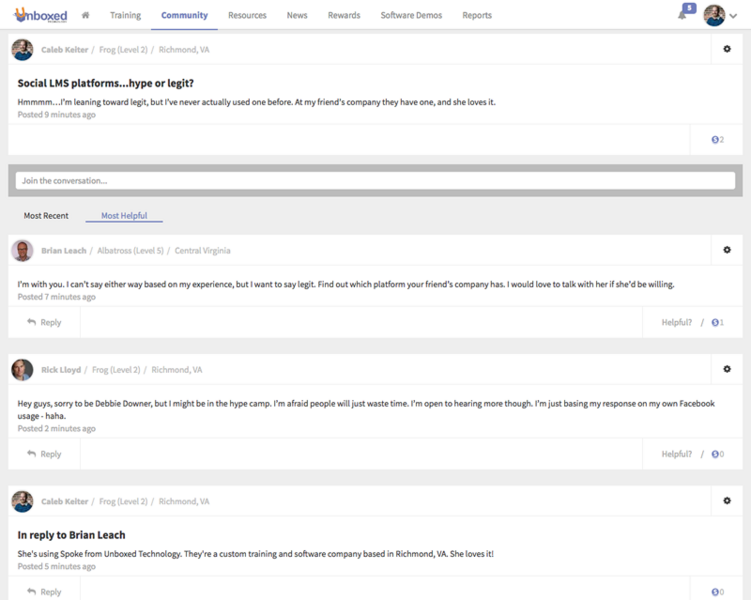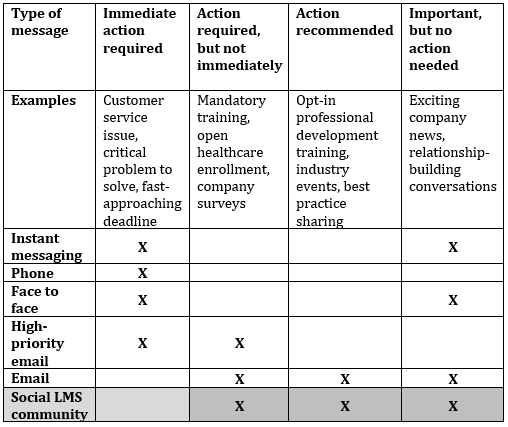ATD Blog
How to Make the Case for a Social LMS
Mon Jun 13 2016



I think we can all agree that there’s a paradigm shift going on in learning and development. We’ve moved from event-based training to workflow-based training. We have a skills gap to bridge and talent to retain. Embracing learning as an ongoing, dynamic process has never been more important.
The ATD study Building a Culture of Learning recently reported that top companies are almost five times more likely than lower performers to have extensive learning cultures. According to the report, “In high-performance organizations, employees share knowledge with their colleagues at a rate four times greater than that of workers in lower-performing firms. That communication is supported by rewarding workers for learning, providing tools and resources for creating and sharing learning content, and making knowledge sharing a performance expectation at all organizational levels.”
One way to develop your company’s learning culture is to use a social learning management system (LMS).
Of course, the word social comes with some baggage. Skeptics associate it with cat videos, idleness, here-today-gone-tomorrow trends, and, from an organizational standpoint, security and liability issues. For some companies, the word social is downright scary. If these concerns sound familiar to you, it probably means your company takes three of its mission-critical assets very seriously:
people
communication systems
values.
And if your company takes people, communication systems, and values seriously—three cheers—you work for the kind of company that can have a social LMS. Any intentional, informed social learning strategy will benefit your people, enhance your communication systems, and align with your values. You just have to do it right.
Understand the Advantages and Disadvantages of a Social LMS
Go in with your eyes wide open. As the Building a Culture of Learning report explains, there’s a huge upside to encouraging employees to share knowledge, rewarding them for learning, and providing tools that make it easy to create and share learning content.
Advantages
Makes learning fun. The best social platforms integrate gamification elements such as leveling-up and surprise badges. They embrace friendly competition with leaderboards. They use witty, conversational language that makes even the busiest, most conservative users smile. A little bit.
Combats brain drain. As we shared previously, one organization stands to lose 27,000 years of expertise when its next wave of Baby Boomers retires. A social LMS captures best practices and makes them accessible to future hires.
Keeps training top-of-mind. Well-designed social learning platforms enable learners to receive email notifications whenever new courses become available, deadlines approach, important company news goes out, and colleagues share helpful content. Notifications encourage learners to jump back in to the community and review what’s new.
Promotes instructional design feedback. If a course is awesome, learners will say so. This lets trainers and instructional designers know they should create more content like it—or at least follow up to understand what’s working well. If a course or resource is out of date, learners will also say so, and your instructional designers can update it.
Connects employees across different locations. You know those rock stars who engage and inspire the employees around them? A social LMS widens their circle of influence so employees across your company can benefit from the voice of your champions, with no travel required.
Establishes (and maintains) camaraderie. Just like Facebook, users can encourage one another by liking posts and adding comments. They show location pride with pictures and shout-outs. Organizations can keep onboarding classes together by creating threads such as Spring 2016 Newbs, Fall 2015 New Hires, etc.
Disadvantages
Okay, now for the disadvantages. These are really just issues you can solve for—but you must solve them! So, in a way, you can think of them as strategic and tactical resourcing considerations for rolling out a social LMS.
Adds a platform to your communication strategy. Company support teams such as communications, operations, and HR value simple, streamlined communication. Having a social community connected to your LMS means you need to be thoughtful about how it complements your other forms of communication. Below is a sample framework you can use.
Requires committed admins. If you’ve ever “cleaned up” your Facebook account, you know what I mean. Admins pin and share helpful posts, remove outdated or inaccurate content, make sure the social community culture reflects the company’s values, and escalate issues and great ideas. The admins are the trusted referees who keep everyone safe.
Tempts time-wasters. Any well-designed source of great content has the power to do so. Think about your favorite website, or the last time you checked out your Twitter feed as a form as procrastination. This is where company values and team management comes in. If your employees care about excellence and doing great work, they won’t waste time for long.
Empowers speaking up. If employees believe company leadership pays attention to social community discussions, they will pose questions and ideas. This is a good thing, because open, honest discussion helps leaders get a pulse on how employees are doing. What’s critical here is that employees feel heard and can see action being taken.
If mitigating these disadvantages sounds like too much work, consider how your efforts will pay off. A well-administered social LMS yields morale-boosting employees comments like this, “One of our customers sent this incredible story in an email to our customer service department about his experience with Josh. This is worth a read, guys! HUGE kudos to Josh for doing such a great job repping the brand!”
And this, “Wow I like how short yet informative these courses are. The positioning \[videos\] are my favorite and they help us think of different ways to position to our customers and they seem real, customer rarely say yes right away—it takes probing, listening and educating to make the sale. \[Company’s product\] in every home is the new mantra.”
Demonstrate Your Vision for How You Want Employees to Use Your Social LMS
If your learners are taking full advantage of your social LMS, what use cases will you see consistently come to life? Here are a few simple-but-awesome examples to get you thinking:
The business development team launches a contest to drive sales of a particular product during Back to School. Contest updates, wins, and tips are posted to a pinned community topic thread.
A well-respected company leader regularly joins forum discussions and posts topics. Employees can "follow" her posts to access what she shares more easily.
A new system is being piloted. Employees take microlearning courses in the social LMS and then complete hands-on practice activities. They notice some system glitches. They bring up the issues in the social community, and developers correct the system problems before scale.
Several job aids employees rely on are out of date. One employee posts a comment about it in the community, and many other employees “like” his comment. The admin sees the comment trending and contacts the training designer, who updates the job aids.
Employees comment about how helpful a new training video is. Your training designers create more like it videos of its tone, length, and caliber.
A company rolls out a new sales process. They ask employees to post user-generated videos of role plays that demonstrate the steps and behaviors involved in the process.
A company uses its social platform to solicit product development ideas. (For Rite-Solutions, this practice led to the development of 15 new products that account for 20% of their total revenue.)
Different locations challenge each other to a dance off to raise awareness for an annual fundraiser. They upload their videos to a pinned community topic thread.
Not bad, right? None of these ideas are too fancy, and the social platform made them easy to execute.
Outline Your Adoption Plan
Wouldn’t it be great to see your social LMS take off like a Beyoncé album or a Justin Bieber carpool karaoke video? (Hey—stop Googling. Stay focused.) According to Forrester in 2015, “Adoption \[of social business software\] is the leading indicator of social business success.”
Bring your social LMS vision to life with a strong adoption plan. There are four key things to consider:
Integration. Everyone loves a great dashboard—especially your sales team. Find out if you can integrate your social LMS into your dashboard, whether it’s a button on the landing page or a tab on your most-trafficked sales hub. The obvious benefit of this is reps can train, access resources, and participate in discussions without jumping from tool to tool.
Champions. Your champions are the high-impact influencers on the front lines who love to get better and help others do the same. Find out who they are, and then tell them your idea about the social LMS. Work with their manager to see if, as a career development opportunity, they could regularly share best practices and comment in the community. You need at least five champions for your initial rollout—more depending on the size of your organization.
Admins. Your admins can make or break the success of your platform, because they’re the bridge between your learners and the rest of the company. Admins should prepare for a moderate level of engagement each day, spent making sure the community tone aligns with your culture and making sure it isn’t cluttered with similar threads. Admins should establish and maintain discussion topics that will keep on giving—topics like “Leadership Skills” and “Closing Techniques.” At least quarterly, admins should review training content and make sure it’s still relevant. New content results in increased engagement. Make sure your team has the training they need to be successful.
Leadership. Senior leadership needs to understand the benefits of a social learning platform, and then they need to join the community! As outlined earlier, the community is a natural place to share exciting company news—and even better—get to know employees and understand what matters to them. In a social context that encourages everyday, conversational language, leaders can even “loosen the tie” and communicate in a personable, more “human” way. For example, what if your CEO captured a quick video on his or her iPhone and thanked everyone for a record-breaking quarter?
Show You Care About Security
Any platform your organization uses must be secure. Make sure to connect your information security team with the social LMS provider you’re considering. Check the mission-critical boxes. Make sure you have unlimited storage, bandwidth, and backups. Demonstrate your admins have a solid track record, strong judgment, and the authority to remove a post if it’s a #valuesfail. Have your users sign an agreement to represent the company values they hold dear when they’re on the platform.
At the end of the day, a social LMS can help you transition from an event-based training culture to a learning culture. One last stat from the Building a Culture of Learning report—you ready? Fewer than one third of organizations have extensive learning cultures. Because high-performance companies are five times more likely than lower performers to have extensive learning cultures, if you make the shift, you’re putting your organization at a huge advantage.
A social LMS also embraces servant leadership, because employees at all levels of the organization can share content and tips that will help others be more successful. And who doesn’t want to work for that company?
You've Reached ATD Member-only Content
Become an ATD member to continue
Already a member?Sign In
